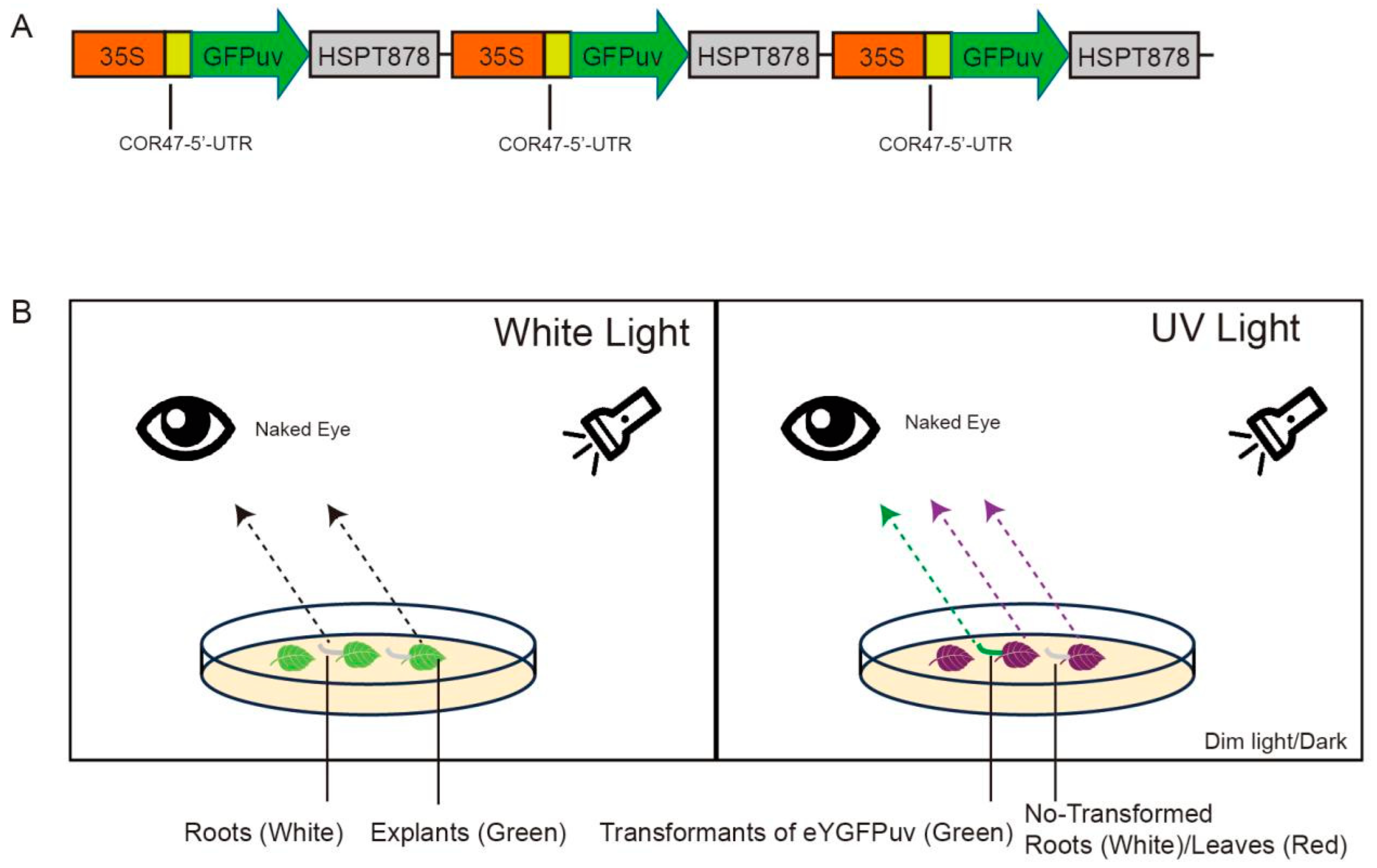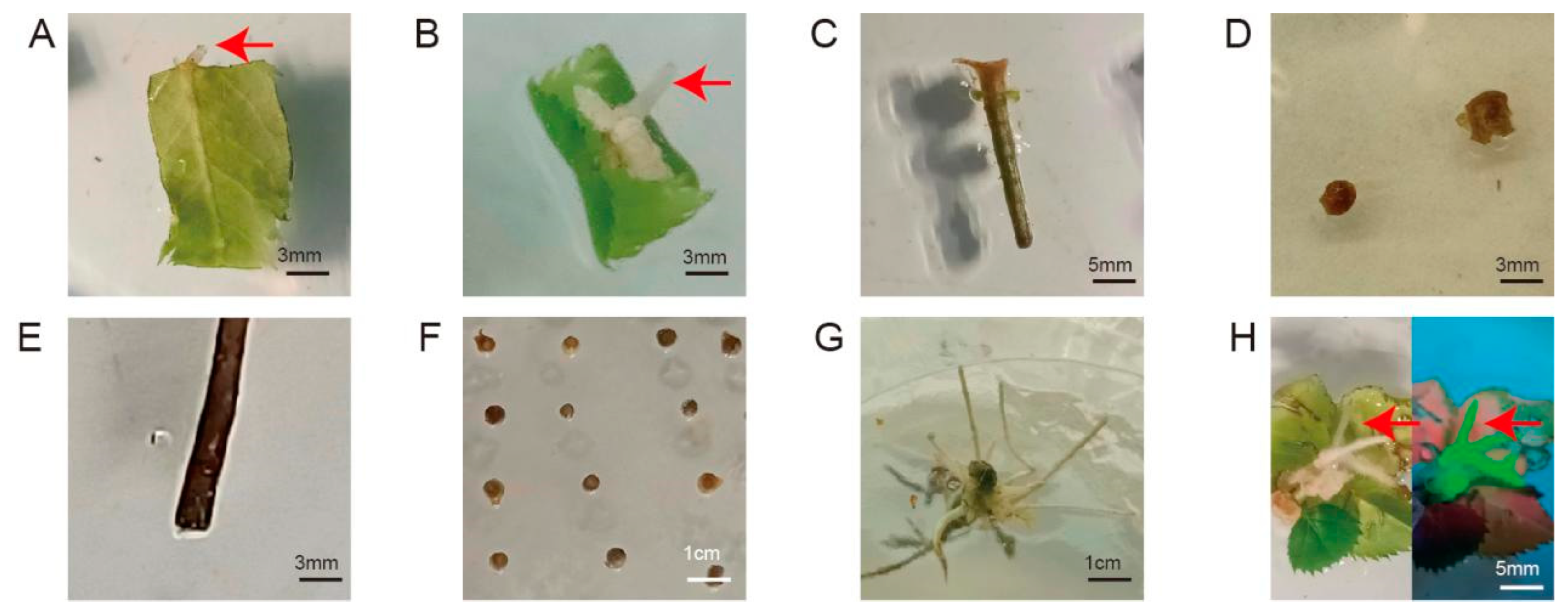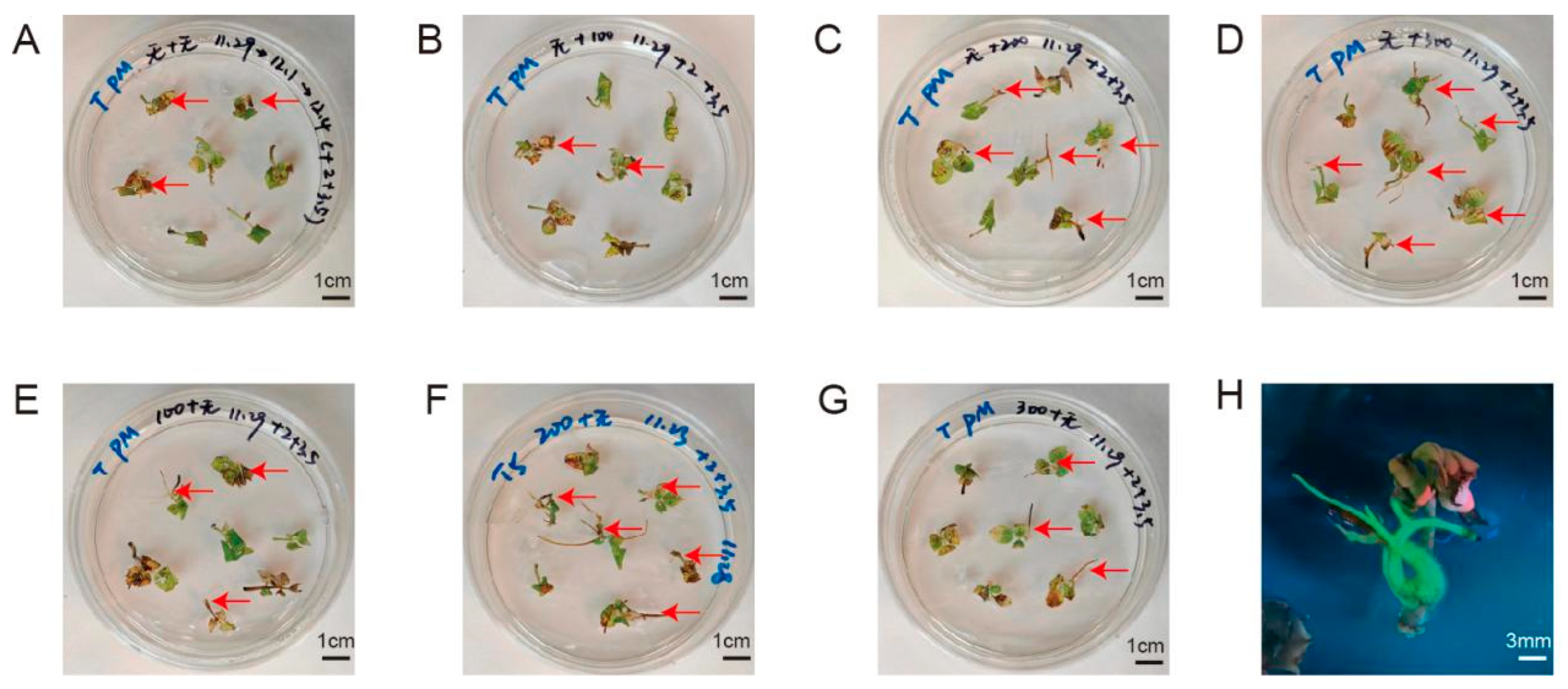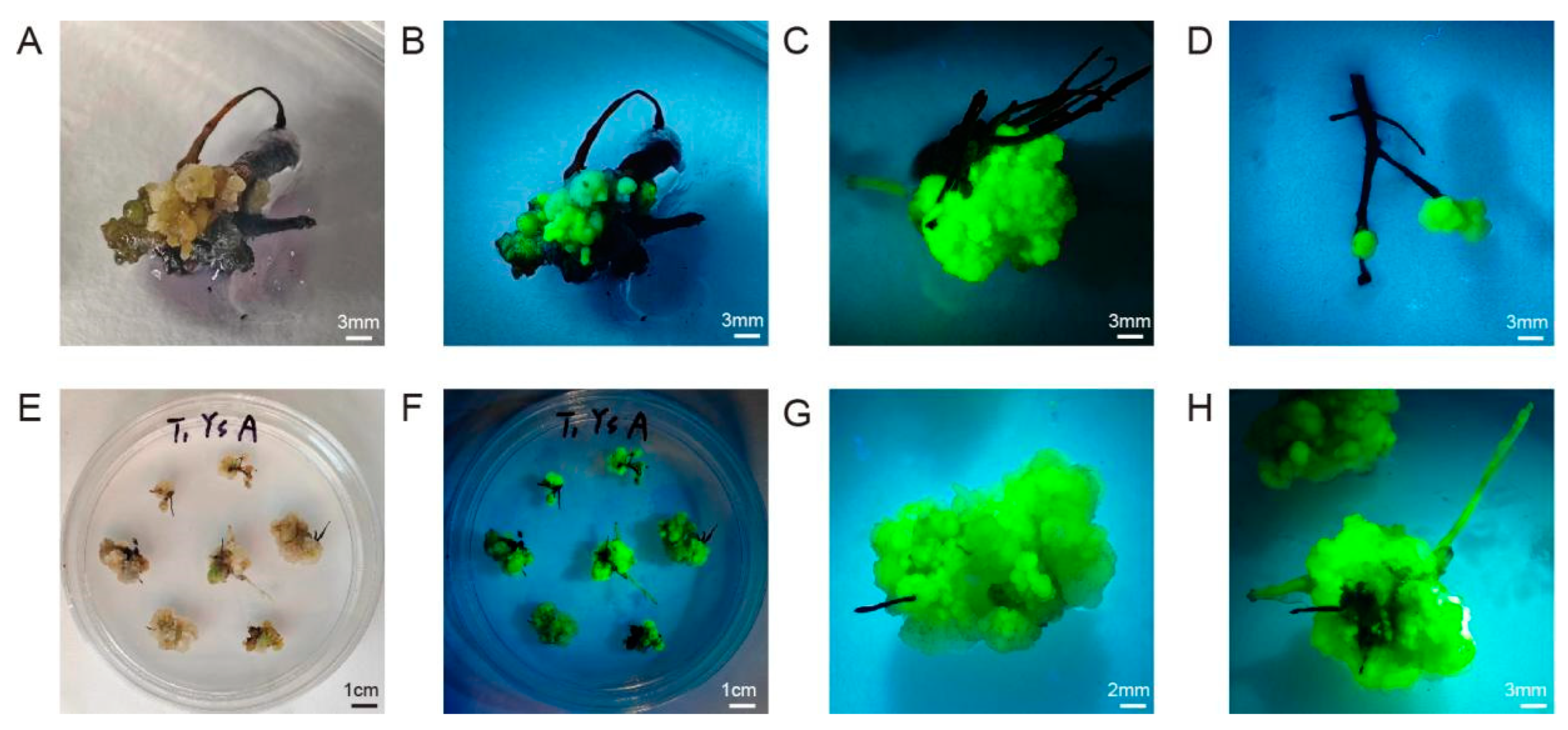Agrobacterium rhizogenes-Mediated Hairy Root Transformation in Rosa
Abstract
:1. Introduction
2. Methods
2.1. Plant Materials
2.2. Agrobacterium Strains and Vectors
2.3. A. rhizogenes-Mediated Hairy Root Transformation
2.4. Fluorescence Assay of Regenerated Hairy Roots
2.5. Statistical Analysis
3. Results
3.1. Effect of Explant Type and Infection Methods on the Induction of Hairy Roots
3.2. Effect of Rose Variety and Agrobacterium rhizogenes Strain on the Induction of Hairy Roots
3.3. Effect of Different Types of Medium on the Rooting Rate of Transgenic Hairy Roots
3.4. Effect of Pre-Cultivation Time and Co-Cultivation Time on the Rooting Rate of Transgenic Hairy Roots
3.5. Effect of Infection Times and Concentrations of Agrobacterium on the Rooting Rate of Transgenic Hairy Roots
3.6. Effect of AS and Carbon Source on the Rooting Rate of Transgenic Hairy Roots
3.7. Effect of Solid Media on the Induction of Callus Tissue by Hairy Roots
3.8. Establishment of a Hairy Root Transformation System in Rose Under Non-Aseptic Conditions
4. Discussion
5. Conclusions
Supplementary Materials
Author Contributions
Funding
Data Availability Statement
Acknowledgments
Conflicts of Interest
References
- Potter, D.; Eriksson, T.; Evans, R.C.; Oh, S.; Smedmark, J.E.E.; Morgan, D.R.; Kerr, M.; Robertson, K.R.; Arsenault, M.; Dickinson, T.A.; et al. Phylogeny and classification of Rosaceae. Plant Syst. Evol. 2007, 266, 5–43. [Google Scholar] [CrossRef]
- Bendahmane, M.; Dubois, A.; Raymond, O.; Le-Bris, M. Genetics and genomics of flower initiation and development in roses. J. Exp. Bot. 2013, 64, 847–857. [Google Scholar] [CrossRef]
- Kurokura, T.; Mimida, N.; Battey, N.H.; Hytonen, T. The regulation of seasonal flowering in the Rosaceae. J. Exp. Bot. 2013, 64, 4131–4141. [Google Scholar] [CrossRef] [PubMed]
- Harmon, D.D.; Chen, H.; Byrne, D.; Liu, W.; Ranney, T.G. Cytogenetics, ploidy, and genome sizes of rose (Rosa spp.) cultivars and breeding lines. Ornam. Plant Res. 2023, 3, 15. [Google Scholar] [CrossRef]
- Reynders-Aloisi, S.; Bollereau, P. Characterisation of genetic diversity in genus Rosa by randomly amplified polymorphic DNA. Acta Hortic. 1996, 424, 253–259. [Google Scholar] [CrossRef]
- Gudin, S. Rose breeding technologies. Acta Hortic. 2001, 547, 23–26. [Google Scholar] [CrossRef]
- Vamosi, J.C.; Dickinson, T.A. Polyploidy and diversification: A phylogenetic investigation in Rosaceae. Int. J. Plant Sci. 2006, 167, 349–358. [Google Scholar] [CrossRef]
- Liang, Y.; Jiang, C.Y.; Liu, Y.; Gao, Y.R.; Lu, J.Y.; Aiwaili, P.; Fei, Z.J.; Jiang, C.Z.; Hong, B.; Ma, C.; et al. Auxin Regulates Sucrose Transport to Repress Petal Abscission in Rose (Rosa hybrida). Plant Cell 2020, 32, 3485–3499. [Google Scholar] [CrossRef] [PubMed]
- Zhang, Y.; Wu, Z.C.; Feng, M.; Chen, J.W.; Qin, M.Z.; Wang, W.R.; Bao, Y.; Xu, Q.; Ye, Y.; Ma, C.; et al. The circadian-controlled PIF8-BBX28 module regulates petal senescence in rose flowers by governing mitochondrial ROS homeostasis at night. Plant Cell 2021, 33, 2716–2735. [Google Scholar] [CrossRef] [PubMed]
- Whitaker, V.M.; Zuzek, K.; Hokanson, S.C. Resistance of 12 rose genotypes to 14 isolates of Diplocarpon rosae Wolf (rose blackspot) collected from eastern North America. Plant Breed. 2007, 126, 83–88. [Google Scholar] [CrossRef]
- Ren, H.R.; Bai, M.J.; Sun, J.J.; Liu, J.Y.; Ren, M.; Dong, Y.W.; Wang, N.; Ning, G.G.; Wang, C.Q. RcMYB84 and RcMYB123 mediate jasmonate-induced defense responses against Botrytis cinerea in rose (Rosa chinensis). Plant J. 2020, 103, 1839–1849. [Google Scholar] [CrossRef]
- Tanaka, Y.; Katsumoto, Y.; Brugliera, F.; Mason, J. Genetic engineering in foriculture. Plant Cell Tissue Organ Cult. 2005, 80, 1–24. [Google Scholar] [CrossRef]
- Kishi-Kaboshi, M.; Aida, R.; Sasaki, K. Genome engineering in ornamental plants: Current status and future prospects. Plant Physiol. Biochem. 2018, 131, 47–52. [Google Scholar] [CrossRef] [PubMed]
- Boutigny, A.L.; Dohin, N.; Pornin, D.; Rolland, M. Overview and detectability of the genetic modifications in ornamental plants. Hortic. Res. 2020, 7, 11. [Google Scholar] [CrossRef] [PubMed]
- Firoozabady, E.; Moy, Y.; Courtney-Gutterson, N.; Robinson, K. Regeneration of transgenic rose (Rosa hybrida) plants from embryogenic tissue. Nat. Biotechnol. 1994, 12, 609–613. [Google Scholar] [CrossRef]
- Liu, G.; Yuan, Y.; Jiang, H.; Bao, Y.; Ning, G.; Zhao, L.; Zhou, X.; Zhou, H.; Gao, J.; Ma, N. Agrobacterium tumefaciens-mediated transformation of modern rose (Rosa hybrida) using leaf-derived embryogenic callus. Hortic. Plant J. 2021, 7, 359–366. [Google Scholar] [CrossRef]
- Tang, J.; Ye, J.X.; Liu, P.X.; Wang, S.Q.; Chen, F.D.; Song, A.P. Ornamental plant gene editing: Past, present and future. Ornam. Plant Res. 2023, 3, 6. [Google Scholar] [CrossRef]
- Vergne, P.; Maene, M.; Gabant, G.; Chauvet, A.; Debener, T.; Bendahmane, M. Somatic embryogenesis and transformation of the diploid Rosa chinensis cv Old Blush. Plant Cell Tissue Organ Cult. 2010, 100, 73–81. [Google Scholar] [CrossRef]
- Chen, J.R.; Chen, Y.B.; Ziemianska, M.; Liu, R.; Deng, Z.N.; Niedzwiecka-Filipiak, I.; Li, Y.L.; Jiao, J.X.; Xiong, X.Y. Co-expression of MtDREB1C and RcXET enhances stress tolerance of transgenic China rose (Rosa chinensis Jacq.). J. Plant Growth Regul. 2016, 35, 586–599. [Google Scholar] [CrossRef]
- Wang, C.P.; Li, Y.; Wang, N.; Yu, Q.; Li, Y.H.; Gao, J.P.; Zhou, X.F.; Ma, N. An efficient CRISPR/Cas9 platform for targeted genome editing in rose (Rosa hybrida). J. Integr. Plant Biol. 2023, 65, 895–899. [Google Scholar] [CrossRef] [PubMed]
- Tian, J.; Pei, H.X.; Zhang, S.; Chen, J.W.; Chen, W.; Yang, R.Y.; Meng, Y.L.; You, J.; Gao, J.P.; Ma, N. TRV-GFP: A modified Tobacco rattle virus vector for efficient and visualizable analysis of gene function. J. Exp. Bot. 2014, 65, 311–322. [Google Scholar] [CrossRef] [PubMed]
- Yan, H.J.; Shi, S.C.; Ma, N.; Cao, X.Q.; Zhang, H.; Qiu, X.Q.; Wang, Q.G.; Jian, H.Y.; Zhou, N.N.; Zhang, Z.; et al. Graft-accelerated virus-induced gene silencing facilitates functional genomics in rose flowers. J. Integr. Plant Biol. 2018, 60, 34–44. [Google Scholar] [CrossRef] [PubMed]
- Lu, J.; Sun, J.J.; Jiang, A.Q.; Bai, M.J.; Fan, C.G.; Liu, J.Y.; Ning, G.G.; Wang, C.Q. Alternate expression of CONSTANS-LIKE 4 in short days and CONSTANS in long days facilitates day-neutral response in Rosa chinensis. J. Exp. Bot. 2020, 71, 4057–4068. [Google Scholar] [CrossRef] [PubMed]
- Sun, J.J.; Liu, H.C.; Wang, W.N.; Fan, C.G.; Yuan, G.Z.; Zhou, R.; Lu, J.; Liu, J.Y.; Wang, C.Q. RcOST1L phosphorylates RcPIF4 for proteasomal degradation to promote flowering in rose. New Phytol. 2024, 243, 1387–1405. [Google Scholar] [CrossRef] [PubMed]
- Chilton, M.D.; Tepfer, D.A.; Petit, A.; David, C.; Casse-Delbart, F.; Tempé, J. Agrobacterium rhizogenes inserts T-DNA into the genomes of the host plant root cells. Nature 1982, 295, 432–434. [Google Scholar] [CrossRef]
- Collier, R.; Fuchs, B.; Walter, N.; Lutke, W.K.; Taylor, C.G. Ex vitro composite plants: An inexpensive, rapid method for root biology. Plant J. 2005, 43, 449–457. [Google Scholar] [CrossRef]
- Liu, S.A.; Su, L.C.; Liu, S.A.; Zeng, X.J.; Zheng, D.M.; Hong, L.; Li, L. Agrobacterium rhizogenes-mediated transformation of Arachis hypogaea: An efficient tool for functional study of genes. Biotechnol. Biotechnol. Equip. 2016, 30, 869–878. [Google Scholar] [CrossRef]
- Gomes, C.; Dupas, A.; Pagano, A.; Grima-Pettenati, J.; Paiva, J.A.P. Hairy root transformation: A useful tool to explore gene function and expression in Salix spp. recalcitrant to transformation. Front. Plant Sci. 2019, 10, 1427. [Google Scholar] [CrossRef] [PubMed]
- Veena, V.; Taylor, C.G. Agrobacterium rhizogenes: Recent developments and promising applications. In Vitro Cell Dev. Biol. Plant. 2007, 43, 383–403. [Google Scholar] [CrossRef]
- Terrier, N.; Torregrosa, L.; Ageorges, A.; Vialet, S.; Verriès, C.; Cheynier, V.; Romieu, C. Ectopic expression of VvMybPA2 promotes proanthocyanidin biosynthesis in grapevine and suggests additional targets in the pathway. Plant Physiol. 2009, 149, 1028–1041. [Google Scholar] [CrossRef] [PubMed]
- Xu, S.L.; Lai, E.H.; Zhao, L.; Cai, Y.M.; Ogutu, C.; Cherono, S.; Han, Y.P.; Zheng, B.B. Development of a fast and efficient root transgenic system for functional genomics and genetic engineering in peach. Sci. Rep. 2020, 10, 2836. [Google Scholar] [CrossRef]
- Fan, Y.L.; Xu, F.L.; Zhou, H.Z.; Liu, X.X.; Yang, X.Y.; Weng, K.X.; Sun, X.L.; Lyu, S.H. A fast, simple, high efficient and one-step generation of composite cucumber plants with transgenic roots by Agrobacterium rhizogenes-mediated transformation. Plant Cell Tissue Organ Cult. 2020, 141, 207–216. [Google Scholar] [CrossRef]
- Fan, Y.L.; Zhang, X.H.; Zhong, L.J.; Wang, X.Y.; Jin, L.S.; Lyu, S.H. One-step generation of composite soybean plants with transgenic roots by Agrobacterium rhizogenes-mediated transformation. BMC Plant Biol. 2020, 20, 208. [Google Scholar] [CrossRef]
- Yu, Y.C.; Xuan, Y.; Bian, X.F.; Zhang, L.; Pan, Z.Y.; Kou, M.; Cao, Q.H.; Tang, Z.H.; Li, Q.; Ma, D.F.; et al. Overexpression of phosphatidylserine synthase IbPSS1 affords cellular Na+ homeostasis and salt tolerance by activating plasma membrane Na+/H+ antiport activity in sweet potato roots. Hortic. Res. 2020, 7, 131. [Google Scholar] [CrossRef] [PubMed]
- Rüter, P.; Wehrenberg, F.; Bartels, J.; Debener, T.; Winkelmann, T. Optimization of Rhizobium rhizogenes-mediated transformation for a diversity set of rose genotypes. Acta Hortic. 2023, 1383, 225–233. [Google Scholar] [CrossRef]
- Rüter, P.; Debener, T.; Winkelmann, T. Unraveling the genetic basis of Rhizobium rhizogenes-mediated transformation and hairy root formation in rose using a genome-wide association study. Plant Cell Rep. 2024, 43, 300. [Google Scholar] [CrossRef]
- Yuan, G.L.; Lu, H.W.; Tang, D.; Hassan, M.M.; Li, Y.; Chen, J.G.; Tuskan, G.A.; Yang, X.H. Expanding the application of a UV-visible reporter for transient gene expression and stable transformation in plants. Hortic. Res. 2021, 8, 234. [Google Scholar] [CrossRef]
- Holsters, M.; de Waele, D.; Depicker, A.; Messens, E.; van Montagu, M.; Schell, J. Transfection and transformation of Agrobacterium tumefaciens. Mol. Gen. Genet. 1978, 163, 181–187. [Google Scholar] [CrossRef]
- Liu, L.; Qu, J.H.; Wang, C.Y.; Liu, M.; Zhang, C.M.; Zhang, X.Y.; Cheng, G.; Wu, C.G.; Yang, G.D.; Huang, J.G.; et al. An efficient genetic transformation system mediated by Rhizobium rhizogenes in fruit trees based on the transgenic hairy root to shoot conversion. Plant Biotechnol. J. 2024, 22, 2093–2103. [Google Scholar] [CrossRef]
- Yi, X.F.; Wang, C.C.; Yuan, X.Q.; Zhang, M.; Zhang, C.W.; Qin, T.J.; Wang, H.Y.; Xu, L.; Liu, L.W.; Wang, Y. Exploring an economic and highly efficient genetic transformation and genome-editing system for radish through developmental regulators and visible reporter. Plant J. 2024, 120, 1682–1692. [Google Scholar] [CrossRef]
- Dohm, A.; Ludwig, C.; Nehring, K.; Debener, T. Somatic embryogenesis in roses. Acta Hortic. 2001, 547, 341–347. [Google Scholar] [CrossRef]
- Ying, W.; Wen, G.C.; Xu, W.Y.; Liu, H.X.; Ding, W.A.; Zheng, L.Q.; He, Y.; Yuan, H.W.; Yan, D.L.; Cui, F.Q.; et al. Agrobacterium rhizogenes: Paving the road to research and breeding for woody plants. Front. Plant Sci. 2023, 14, 1196561. [Google Scholar] [CrossRef] [PubMed]
- Bahramnejad, B.; Naji, M.; Bose, R.; Jha, S. A critical review on use of Agrobacterium rhizogenes and their associated binary vectors for plant transformation. Biotechnol. Adv. 2019, 37, 107405. [Google Scholar] [CrossRef]
- Predieri, S.; Drizzi, G.; Gatti, E. Effect of nitrogen supply on rooting of pear (Pyrus communis L.) cv. Conference microcuttings. Adv. Hortic. Sci. 1999, 13, 68–70. [Google Scholar]
- Ziemienowicz, A. Agrobacterium-mediated plant transformation: Factors, applications and recent advances. Biocatal. Agric. Biotechnol. 2014, 3, 95–102. [Google Scholar] [CrossRef]
- Zhao, J.T.; Li, Z.J.T.; Cui, J.; Henny, R.J.; Gray, D.J.; Xie, J.H.; Chen, J.J. Efficient somatic embryogenesis and Agrobacterium-mediated transformation of pothos (Epipremnum aureum) ‘Jade’. Plant Cell Tissue Organ Cult. 2013, 114, 237–247. [Google Scholar]
- Lai, E.M.; Kado, C.I. Processed VirB2 is the major subunit of the promiscuous pilus of Agrobacterium tumefaciens. J. Bacteriol. 1998, 180, 2711–2717. [Google Scholar] [CrossRef]
- Gelvin, S.B. Agrobacterium virulence gene induction. Methods Mol. Biol. 2006, 343, 77–84. [Google Scholar]
- Cao, X.S.; Xie, H.T.; Song, M.L.; Lu, J.H.; Ma, P.; Huang, B.Y.; Wang, M.G.; Tian, Y.F.; Chen, F.; Peng, J.; et al. Cut–dip–budding delivery system enables genetic modifications in plants without tissue culture. Innovation 2023, 4, 100345. [Google Scholar] [CrossRef] [PubMed]
- Cao, X.S.; Xie, H.T.; Song, M.L.; Zhao, L.H.; Liu, H.L.; Li, G.F.; Zhu, J.K. Simple method for transformation and gene editing in medicinal plants. J. Integr. Plant Biol. 2024, 66, 17–19. [Google Scholar] [CrossRef]
- Ma, H.J.; Liu, N.G.; Sun, X.P.; Zhu, M.L.; Mao, T.F.; Huang, S.Y.; Meng, X.Y.; Li, H.F.; Wang, M.; Liang, H.L. Establishment of an efficient transformation system and its application in regulatory mechanism analysis of biological macromolecules in tea plants. Int. J. Biol. Macromol. 2023, 244, 125372. [Google Scholar] [CrossRef]
- Wang, H.Y.; Zheng, Y.S.; Zhou, Q.; Li, Y.; Liu, T.K.; Hou, X.L. Fast, simple, efficient Agrobacterium rhizogenes-mediated transformation system to non-heading Chinese cabbage with transgenic roots. Hortic. Plant J. 2024, 10, 450–460. [Google Scholar] [CrossRef]
- Lu, J.H.; Li, S.S.; Deng, S.; Wang, M.G.; Wu, Y.H.; Li, M.; Dong, J.S.; Lu, S.H.; Su, C.L.; Li, G.F.; et al. A method of genetic transformation and gene editing of succulents without tissue culture. Plant Biotechnol. J. 2024, 22, 1981–1988. [Google Scholar] [CrossRef] [PubMed]
- Chen, J.H.; Tian, Y.R.; Li, A.J.; Xia, X.L.; Lin, W.L. Jasmonic acid signaling and its research progress in woody plants. Sci. Sin. Vitae 2019, 50, 215–226. [Google Scholar]
- Han, X.; Kui, M.Y.; He, K.R.; Yang, M.L.; Du, J.C.; Jiang, Y.J.; Hu, Y.R. Jasmonate-regulated root growth inhibition and root hair elongation. J. Exp. Bot. 2022, 74, 1176–1185. [Google Scholar] [CrossRef] [PubMed]








| Different Types of Treatments | Different Types/Factors | ||||
|---|---|---|---|---|---|
| Explants | Leaf Discs | Leaf discs with petiole segments | |||
| Petiole | Ovaries | ||||
| Stem segment | Transverse slices | ||||
| Compound leaves | Rootless seedlings | ||||
| Agrobacterium strains | MSU440 | Ar Qual | Ar 1193 | ||
| Medium | MS | 1/2 MS | 1/4 MS | 1/2 MS + 0.05 NAA | |
| Pre-cultivation time (d) | 0 | 1 | 2 | ||
| Co-cultivation time (d) | 1 | 2 | 3 | 4 | |
| Infection time (min) | 0 | 15 | 30 | 45 | 60 |
| OD600 | 0.4 | 0.8 | 1.2 | 1.6 | |
| Concentration of AS (μmol/L) | 0 | 100 | 200 | 300 | |
| Carbon source | Glucose | Sucrose | |||
| Rosa Cultivars | MSU440 | Ar Qual | Ar 1193 | |||
|---|---|---|---|---|---|---|
| Rooting Rate (%) | Fluorescence- Positive Rate (%) | Rooting Rate (%) | Fluorescence- Positive Rate (%) | Rooting Rate (%) | Fluorescence- Positive Rate (%) | |
| “Pink mooscoe” | 25.4 ± 9.90 ab | 31.9 ± 3.39 a | 30.7 ± 6.11 a | 24.4 ± 2.23 a | 10.7 ± 6.11 b | 8.9 ± 7.79 b |
| “Samantha” | 19.5 ± 4.79 a | 33.1 ± 3.71 a | 21.1 ± 2.14 a | 30.6 ± 2.81 a | 12.7 ± 11.98 a | 7.8 ± 7.24 b |
| “Grevillei” | 4.8 ± 2.06 b | 0 b | 9.5 ± 2.06 a | 14.3 ± 4.11 a | 0 c | 0 b |
| “Old Blush” | 5.7 ± 5.88 a | 0 a | 2.9 ± 2.51 a | 0 a | 0 b | 0 a |
| “Sichun” | 0 a | 0 a | 0 a | 0 a | 0 a | 0 a |
| “Suehime” | 0 a | 0 a | 0 a | 0 a | 0 a | 0 a |
| “Hiogi” | 0 a | 0 a | 0 a | 0 a | 0 a | 0 a |
| “Purple branch” | 0 a | 0 a | 0 a | 0 a | 0 a | 0 a |
| Types of Medium | R. hybrida “Pink Mooscoe” | R. hybrida “Samantha” | ||
|---|---|---|---|---|
| Rooting Rate (%) | Fluorescence- Positive Rate (%) | Rooting Rate (%) | Fluorescence- Positive Rate (%) | |
| MS | 14.1 ± 5.86 b | 14.0 ± 2.81 b | 5.2 ± 1.76 c | 0 b |
| 1/2 MS | 21.6 ± 2.10 b | 17.9 ± 2.01 ab | 23.8 ± 2.08 b | 22.5 ± 4.36 a |
| 1/4 MS | 30.8 ± 3.85 a | 20.9 ± 0.81 a | 49.4 ± 11.36 a | 24.8 ± 6.13 a |
| 1/2 MS + 0.05 NAA | 18.9 ± 3.89 b | 15.0 ± 2.37 b | 34.9 ± 3.87 b | 22.7 ± 5.95 a |
Disclaimer/Publisher’s Note: The statements, opinions and data contained in all publications are solely those of the individual author(s) and contributor(s) and not of MDPI and/or the editor(s). MDPI and/or the editor(s) disclaim responsibility for any injury to people or property resulting from any ideas, methods, instructions or products referred to in the content. |
© 2025 by the authors. Licensee MDPI, Basel, Switzerland. This article is an open access article distributed under the terms and conditions of the Creative Commons Attribution (CC BY) license (https://creativecommons.org/licenses/by/4.0/).
Share and Cite
Lu, J.; Huang, Y.; Guo, Y.; Fan, C.; Yuan, G.; Zhou, R.; Sun, J.; Bai, M.; Wang, K.; Liu, J.; et al. Agrobacterium rhizogenes-Mediated Hairy Root Transformation in Rosa. Horticulturae 2025, 11, 49. https://doi.org/10.3390/horticulturae11010049
Lu J, Huang Y, Guo Y, Fan C, Yuan G, Zhou R, Sun J, Bai M, Wang K, Liu J, et al. Agrobacterium rhizogenes-Mediated Hairy Root Transformation in Rosa. Horticulturae. 2025; 11(1):49. https://doi.org/10.3390/horticulturae11010049
Chicago/Turabian StyleLu, Jun, Yuwen Huang, Yuhan Guo, Chunguo Fan, Guozhen Yuan, Rui Zhou, Jingjing Sun, Mengjuan Bai, Kun Wang, Jinyi Liu, and et al. 2025. "Agrobacterium rhizogenes-Mediated Hairy Root Transformation in Rosa" Horticulturae 11, no. 1: 49. https://doi.org/10.3390/horticulturae11010049
APA StyleLu, J., Huang, Y., Guo, Y., Fan, C., Yuan, G., Zhou, R., Sun, J., Bai, M., Wang, K., Liu, J., & Wang, C. (2025). Agrobacterium rhizogenes-Mediated Hairy Root Transformation in Rosa. Horticulturae, 11(1), 49. https://doi.org/10.3390/horticulturae11010049






